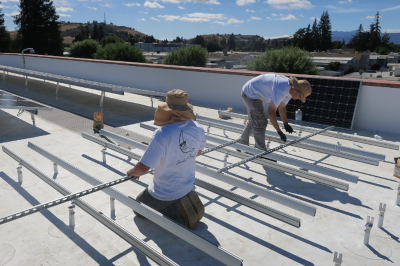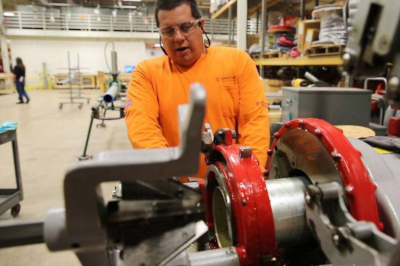The National Electrical Contractors Association
Technology development in the field
The National Electrical Contractors Association and how they are adapting to a wide range of disruptive forces on a daily basis.
In recent years, technology has impacted the lives of electrical contractors in the United States in a fundamental way. Most need look no further than the smart phones in their pockets. Those devices, and their associated, interconnected apps, serve as an example of a recent advancement that has influenced the way the electrical construction industry does business. And in the National Electrical Contractors Association (NECA), companies of all sizes are adapting to a wide range of disruptive forces on a daily basis.
“The digital revolution has completely changed the game,” NECA CEO John M. Grau said. “Innovations in technology are keeping contractors competitive in the workforce and helping us attract new talent to the industry.”
 NECA is the voice of the $160 billion industry that brings power, light, and communication technology to buildings and communities across the U.S. With national offices in Bethesda, Md., and 119 local chapters, it routinely showcases members doing cutting-edge work. That includes its annual convention and trade show every fall that features an expanded exhibit aptly named TECHTOPIA. This exhibit offers an in-depth look at emerging trends and technologies transforming construction.
NECA is the voice of the $160 billion industry that brings power, light, and communication technology to buildings and communities across the U.S. With national offices in Bethesda, Md., and 119 local chapters, it routinely showcases members doing cutting-edge work. That includes its annual convention and trade show every fall that features an expanded exhibit aptly named TECHTOPIA. This exhibit offers an in-depth look at emerging trends and technologies transforming construction.
“It’s important that electrical professionals know how this is affecting their businesses,” Grau said.
The cost of technology is one piece of the puzzle, Grau added, but it’s not necessarily the hardest part to address. Realizing the need to shift course comes first. “The decision to invest in the first place takes more time and consideration,” he said.
One of the places where the money is heading: advanced processes such as building information modeling (BIM). BIM involves the generation and management of digital representations of physical and functional characteristics of places. Now a driving force in electrical construction, the three-dimensional design program lets electrical contractors create a building’s electrical system virtually within a project’s digital construction drawings. With the advancement of BIM, using prefabrication methods in residential and commercial projects has re-emerged as a growing trend in the industry. Assembling modular units ahead of time helps contractors improve productivity, and as they’ve become more efficient at starting and ending jobs, they can increase the volume and complexity of assignments.
“Electrical contractors are ‘prebuilding’ systems that can be brought to the construction site ready for installation right away,” Grau said. “In most cases, that means a smaller on-site construction presence will be required.”
Other types of technology making waves among electrical contractors include unmanned aerial vehicles (commonly referred to as UAVs and drones) and wearables. Drones are used in everything from power and pipeline inspections and agriculture to real estate and law enforcement, with their central purpose being information-gathering. In electrical construction, installation crews often keep drones in the back of their trucks because they can be used to inspect areas that are hard to access. Simply put, drones are becoming an increasingly indispensable tool in the industry.
Similarly, Power Over Ethernet (POE) is a dynamic innovation impacting a range of technologies such as lighting, signal devices, fire alarm systems, video, and security cameras and systems. Michael J. Johnston, NECA’s Executive Director of Standards and Safety, said codes and standards are being modified to address safety concerns and that NECA and the industry will continue to track the trend and adjust when it is necessary. “Electrical contractors will be installing POE-based equipment more often moving forward,” Johnston said.
 Electrical contractors also benefit from an increase in opportunities to install electric vehicle supply equipment in homes, businesses, and public areas such as freeways. And since about 25 percent of power on the planet is derived from renewable energy sources, it will be essential that systems include some kind of companion energy storage system such as a battery. That includes both older, wet-cell batteries and newer Lithium-type technology. “Battery technologies are evolving at a rapid pace,” Johnston added.
Electrical contractors also benefit from an increase in opportunities to install electric vehicle supply equipment in homes, businesses, and public areas such as freeways. And since about 25 percent of power on the planet is derived from renewable energy sources, it will be essential that systems include some kind of companion energy storage system such as a battery. That includes both older, wet-cell batteries and newer Lithium-type technology. “Battery technologies are evolving at a rapid pace,” Johnston added.
Additional breakthroughs – autonomous vehicles, artificial intelligence and big data – will continue to impact electrical contractors for years to come. Some changes, however, are still far off. “The notion of robots replacing humans on the construction site is an interesting point of discussion, but that looks unlikely,” Grau said.
That’s not the case for a ubiquitous form or communication: smart phones and tablets. The so-called Internet of Things has brought about meaningful change, streamlining processes in incalculable ways. Contractors are making daily reports, tracking time, documenting progress with pictures, implementing safety plans, and ensuring quality control all in the palm of their hands.
Many apps, including some created by NECA, are helping contractors. The NECA Safety Meeting App is a prime example. It is an increasingly important tool designed to streamline the process of holding required safety meetings and delivering required jobsite safety talks. It was developed specifically for contractors to provide a consistent, cloud-based, user-friendly platform to efficiently manage their company’s safety meetings and document them as required by the Occupational Safety and Health Administration. The NECA PPE App, likewise, was designed as a mobile-friendly alternative to the popular NFPA 70E Personal Protective Equipment (PPE) Selector Guide. It was developed to assist the electrical construction industry in understanding and applying the provisions found in “NFPA 70E, The Standard for Electrical Safety in the Workplace,” which has become the foremost industry resource on the subject.
NECA also developed apps for news and events and its advocacy efforts. There’s even one for the monthly ELECTRICAL CONTRACTOR magazine, which features a page-by-page version of the monthly magazine, a text-only mobile-friendly version and a hybrid solution.
“Learning to incorporate new technology into our lives and forge ahead will always be a challenge, but NECA is up to it,” Grau said. “It’s exciting to look at where we as an industry are going.”
Check out this handpicked feature on Werner Electric Ventures, LLC – Solution, Supply, Support.
AT A GLANCE
WHO: The National Electrical Contractors Association
WHAT: The voice of the electrical construction industry
WHERE: Bethesda, Maryland
WEBSITE: www.necanet.org

